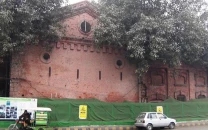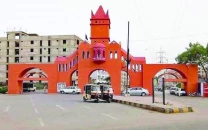Manchhar breached to save Sehwan
Five union councils flooded through controlled breach to save hundreds of thousands souls

The Sindh government finally took the plunge of cutting open a small portion of the Manchhar lake’s bank on Sunday in a desperate attempt to protect Sehwan and Bhan Saeedabad from flooding, displacing some 125,000 people in five union councils to saving over 300,000 others.
Sindh Chief Minister Syed Murad Ali Shah, who visited the lake, said that the authorities concerned felt compelled to take that decision because the strong winds on Saturday night had begun to propel gushing water from the lake across the levees.
“These five UCs [Jaffarabad, Talti, Channa, Aarazi and Bubak] will be taking water,” the chief minister said, referring to the torrents coming from parts of Balochistan and Larkana division, which raised Manchhar to a dangerous level.
There was fear that if the overflowing water was not channelled towards those UCs, Sehwan and Bhan Saeedabad would be inundated. The cut in the bank was made, near Bagh Yusuf, after the lake overflowed near Bubak.
Sehwan has a population of around 300,000 souls, while the five UCs combined were estimated to be inhabited by more than 125,000 people. According to an estimate, 50,000 to 60,000 people had already moved out of their homes before Sunday sunset.
Read More Sindh flood victims pour into Balochistan
The Sehwan Airport, an installation of an oil company as well as Sindh Chief Minister Shah’s home village were located in these five UCs. Shah said that he himself had become flood-affected, as “now the water from the breach is heading towards my village, Wahar”.
He added that Bajara – the town, where his father and former chief minister the late Syed Abdullah Shah was born – was flooded on Saturday. He denied that ruptures had occurred in the Main Nara Valley (MNV) drain, which fed Manchhar.
Most of the displaced people headed towards camps in Jamshoro and Kotri, at least 150 kilometres away. The people who had left their homes early, sought refuge in the town of Sehwan which could not accommodate tens of thousands of the displaced people.
Jamshoro Deputy Commissioner Capt (retd) Fariduddin Mustafa claimed that they had arranged relief items for the displaced people in advance because the breaches or the spillover from the lake was anticipated for a few days.
‘Difficult decision’
The situation at Manchhar, the largest natural freshwater lake in Pakistan, was becoming critical with each passing day, threatening the lives and assets of the residents of five union councils of Jamshoro district.
The water level had increased amid strong winds. On Sunday, the water level was 120.75 feet in the lake and it was increasing to the dangerous level of 123 feet. The Sindh Irrigation Department said that the cut decreased 30% water pressure in the lake.
The lake was receiving around 40,000 cusecs water from the MNV drain, which channelled the hill torrents from Balochistan. However, only around 25,000 cusecs was released in the Indus river, while 15,000 cusecs had been retained in the lake.
“We had to take this difficult decision,” Sindh Information and Transport Minister Sharjeel Inam Memon told a press conference in Hyderabad. “The government decided to cut lake’s levee to save hundreds of thousands of residents of Sehwan and Bhan Saeedabad.”
Irrigation Minister Jam Khan Shoro while speaking to The Express Tribune, also confirmed that the cut was made to reduce pressure on the lake and to secure Dadu, Mehar and Sehwan. “Technically, it was necessary,” he said, adding that a few UCs were affected after the cut.
The flood situation at Manchar is expected to last eight to 10 days. The lake’s water will ultimately be released in the Indus river in a large quantity only after reduction of the flood level in the river.
Shoro said that the barrage authorities had planned to hold the river water at Guddu and Sukkur barrages to decrease the flows towards Kotri in order to allow the Indus to take Manchhar’s discharge.
Later, on the request of the civil administration, the Pakistan army started strengthening the weak embankments of Manchhar lake. The army’s Corps of Engineers rushed to the lake to repair the broken parts and prevent walls from collapsing.
Indus flood
Record monsoon rains and melting glaciers in Pakistan’s northern mountains have brought calamitous floods of epic proportion.
Sindh, with a population of 50 million, was the hardest hit, getting 464% more rain than the 30-year average.
Aside from historic rainfall, Sindh has had to contend with increased flooding as a surge of water flowed down the Indus river. Being downstream on the Indus, the southern parts of the country have witnessed swelling river waters flowing from the north.
The water has started receding at upper Sindh barrages with low to medium flood at Guddu and medium flood at Sukkur barrage on Sunday. The water inflow and outflow at Guddu barrage was measured 474,795 cusecs and 534,650 cusecs at Sukkur.
The Federal Flood Commission (FFC) said that the Indus continued to flow in “high flood” in Sukkur-Kotri Reach and in “medium flood” at Guddu, while complete normalcy has returned to River Kabul.
According to daily FFC report on Sunday, the River Indus is discharging normal flows at rest of its control structures (Tarbela, Kalabagh, Chashma and Taunsa). Other main rivers of Indus River System – Jhelum, Chenab, Ravi and Sutlej continued to flow with normal discharges.
Meanwhile, authorities also prepared for more rain in the north over the next few days up until Tuesday. “Pakistan Meteorological Department (PMD) has forecasted that weak monsoon currents from Arabian Sea are penetrating upper and central parts of the country which subsequently cause rain-wind / thundershowers,” the NDMA said in an advisory.
(WITH INPUT FROM AGENCIES)



















COMMENTS
Comments are moderated and generally will be posted if they are on-topic and not abusive.
For more information, please see our Comments FAQ